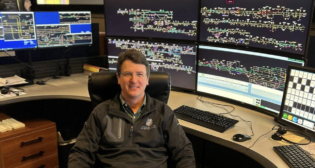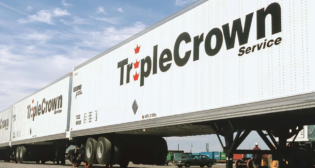
Be Informative and Collective. Raise Awareness and Perceptions
Written by Nicholas Little, Director Railway Education, Center for Railway Research and Education, Michigan State University Eli Broad College of BusinessA year ago, news was emerging from Wuhan, China about a new, dangerous form of flu. My stepson and his Chinese-born wife wisely cancelled their planned trip to China to celebrate the Chinese New Year with her family. Since then, we have all experienced significant disruption to our lives.
Forecasters and rail industry analysts had expected 2020 to be a year of slow but steady growth compared to 2019. Passenger traffic was expected to grow. In 2019, Amtrak’s fare revenue was close to covering operating costs. Commuter rail traffic was also increasing as many people turned away from cars and road congestion. An improving economy was also expected to increase rail freight traffic.
My first article in this series talked about different recovery scenarios. As with most forecasts, they were all wrong. I never expected to be working from home for what could now possibly extend to 15-18 months. We never anticipated widespread lockdowns or quarantining, let alone the vast number of COVID-19 related deaths worldwide.
The railroad industry took a significant hit. Dealing with the unexpected is second nature to everyone working in the industry. Passenger services quickly met the needs of essential workers and implemented safety measures to protect travelers and staff. Freight rail was declared essential to the economy. Additional PPE and cleaning routines and measures to accommodate social distancing were quickly put in place.
During the height of the lockdowns in the first phase of the pandemic, shuttered factories reduced demand for raw materials and bulk goods. Reduced truck and car traffic lowered demand for oil and petroleum products to be moved by train. The automotive manufacturing shutdown hit the railroads very hard, from steel to finished automobiles. Many other carload and unit train commodities were impacted.
As an industry, we took stock. We looked for efficiencies wherever possible. Surplus locomotives were stored, as were railcars. About the only good thing to come from all of this was a significant improvement in air quality due to less pollution from different sources, not just transportation.
Even intermodal traffic fell dramatically through the first and most of the second quarter of 2020. International intermodal took a hit from the double-whammy of the Chinese New Year and then the pandemic-driven shutdown of production in China. North American inventories, already low, were rapidly depleting in key areas.
Then, toward the end of May and into June, consumer spending responded to the first stimulus payments. Consumer goods started moving again. International and domestic intermodal traffic picked up. Inventories began to build again. Intermodal has steadily grown through the second half of 2020, hitting an all-time record high one week in December. The traditional “holiday surge” came early, lasted longer and is expected to continue well into 2021.
As I write, ports are handling record amounts of import cargo. Loaded container ships are awaiting berths at many ports on both west and east coasts. Containers themselves are in short supply. Demand for drayage and longer distance trucking from those ports is high, as are prices. Trains from the ports are full and train length has increased. We must ensure we are optimizing asset utilization from the well car fleet. Even TOFC demands are high and have temporarily (?) reversed the declines experienced in the last few years. E-commerce, for both consumer and business markets, increased substantially and looks likely to remain at a high proportion of total business.
Looking forward, will this continue and, if so, for how long? Earlier this month, the second stimulus payments were made. The Biden Administration may add further consumer stimuli. Economists believe this cash will not be spent immediately. They suggest that it will be spent over time on goods rather than services. That can only be good news for the transportation industry. We need to make sure it is good news for rail freight.
As longer trains improve efficiency, thereby helping improve operating ratios, they also make operating the network more difficult. Recent investments in technology are helping. Information from sensors, both wayside and onboard, improves performance. We are able to change maintenance from failure-driven events to predictive triggers. Using accurate, reliable, and timely data can improve all aspects of the complex railway ecosystem.
Better data-driven decision-making in everything we do results in better performance, better customer relationships, and better stakeholder returns and perceptions. I see freight railroads following some passenger railroads examples when it comes to providing information on tracking and delivery times. Behind the scenes, we are using data to improve service. We are using PTC as a platform, combined with PSR and other management tools to fine-tune operations, communicate well ahead of interchange, and share important information with customers, shippers and receivers.
Railroading is no longer about just running trains (I strongly argued it never was). Freight railroads the world over are transforming themselves to think and act as part of their customers’ supply chains. Passenger railroads see themselves as part of end-to-end (door-to-door) journeys whether for commuting, social or tourism. Passenger rail is multi-modal as the term “mobility” is becoming commonly used to describe this integrated service.
Michigan State University is looking at sociomobility. Combining several colleges’ expertise and knowledge (business, engineering, social studies and more) enables a wide look at the conflux of different viewpoints, research and data, predominantly for passenger mobility.
MSU is also using its long-established position as a supply chain education and knowledge leader to reimagine modal choice for freight and explore the multi-modal linkages necessary to provide integrated, end-to-end service. Freight mobility? Who knows? What will be the next transformational factor in our industry?
While writing this, I recalled a discussion I had that nearly ended my railway career before it had officially started. While still at school, I had a summer vacation job at my local train station back in the U.K. One day, when things were not going to plan or timetable, my Superintendent, in the latter stage of his railway career, said “We could run the trains on time if it wasn’t for the passengers.” I respectfully (or so I thought) pointed out that passenger fares helped pay his and everyone else’s wages. He didn’t see it the same way!
I recently judged 101 nominations for Railway Age’s “20 Under 40: Fast Trackers.” Every nominee demonstrated their passion, knowledge, experience and dedication. Our industry has a great future if we can retain the best of this talent pool.
The rail industry in North America is changing very fast. New people with different perspectives and experiences, efficiency improvements and technology lead to willingness to collaborate and work together to compete with other transportation modes. We must not rest on our environmental advantage alone— that differentiator is reducing, and could disappear, if electric, or other low- or zero-emission trucks, are widely adopted.
We must look to keep our customers and policy makers aware of what railroads do, how well we do it and how what we do contributes to society. There will be opportunities with the new Administration in Washington, D.C. to state our case. We need to be informative, collective and raise awareness as well as perceptions.



